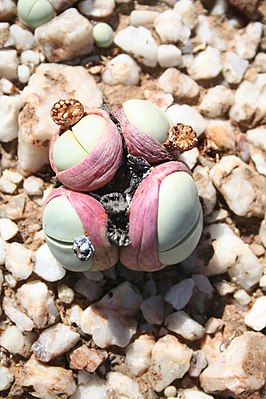Argyroderma
| Argyroderma | ||||||||||||
|---|---|---|---|---|---|---|---|---|---|---|---|---|

Argyroderma sp. in the Knersvlakte |
||||||||||||
| Systematics | ||||||||||||
|
||||||||||||
| Scientific name | ||||||||||||
| Argyroderma | ||||||||||||
| NEBr. |
Argyroderma is a plant kind from the family of aizoaceae (Aizoaceae). The botanical name of the genus is derived from the Greek words ἄργρος (argyros) for "silver" and δέρμα (derma) for "skin" and refers to the silver gray-green leaves of the plants.
description
The plants of the genus Argyroderma are perennial plants that grow turf-forming to compact. In some species, the leaves are reduced to a single pair of leaves. Some species grow sunk into the ground. The silver to gray-green, opposite leaves are finger- to thumb-shaped and more or less rounded. The leaf pairs are fused together at the base. Their smooth epidermis is not spotted or warty and has deeply sunken stomata . The epidermis is made up of cells with very thick walls and contains a thick layer of crystal sand . Old leaves often stay on the plants for several years.
The individual, stalked, yellow, purple, red or rarely white flowers have bracts and a clear flower cup 2 to 4 millimeters in length. Your 6 to 8 sepals are fused into a short tube. The standing in a dense ring stamens are bent inwards and the cover at the top of the ovary contained small annular pad consisting of overgrown scars is. The 10- to 24-paced capsule fruits are similar to those of the genus Leipoldtia , but have rather narrow flaps. The flower cup remains on the capsule until the next rainy season. The smooth brown seeds are more or less rounded and 0.5 to 0.85 millimeters long and 0.35 to 0.65 millimeters wide.
The flowering time of the plants begins in their homeland in April and lasts until June. The flowers open at noon and close again in the evening.
Systematics, number of chromosomes and distribution
The distribution area of the genus Argyroderma lies in the northwest of the South African province of Western Cape in the semi-desert Knersvlakte and extends from Vanrhynsdorp to Vredendal . The plants grow on plains containing quartzite or on slopes, rarely on sandy or slightly salty plains. The annual rainfall is less than 200 millimeters, with the majority falling in winter.
The chromosome number is .
The first description was published in 1922 by Nicholas Edward Brown . The type species is Argyroderma testiculare . According to Heidrun Hartmann , the genus is divided into two sub-genera and includes the following species:
- Subgenus Argyroderma
- Argyroderma congregatum
- Argyroderma crateriforme
- Argyroderma delaetii
-
Argyroderma framesii
- Argyroderma framesii subsp. framesii
- Argyroderma framesii subsp. hallii
- Argyroderma × octophyllum
- Argyroderma patens
- Argyroderma pearsonii
- Argyroderma wrestling
- Argyroderma subalbum
- Argyroderma testiculare
- Argyroderma theartii
- Subgenus Roodia
The hybrid Argyroderma × octophyllum also belongs to the genus.
proof
literature
- PS Green, Klaus Kubitzki, E. Götz, KU Kramer: The Families and Genera of Vascular Plants . Volume 1, p. 66, Springer, 1990, ISBN 3-540-55509-9
- Heidrun EK Hartmann: Illustrated Handbook of Succulent Plants: Aizoaceae AE , Springer Verlag, Berlin / Heidelberg / New York 2001, pp. 70–75, ISBN 3-540-41691-9
- Gideon Smith et al. a .: Mesembs of the World: Illustrated Guide to a Remarkable Succulent Group . Briza Publications 1998, pp. 82-84. ISBN 1-875093-13-3
Individual evidence
- ↑ Gardeners' Chronicle . Series 3, vol. 71, p. 92, London 1922
- ↑ Heidrun EK Hartmann: Illustrated Handbook of Succulent Plants: Aizoaceae AE , Springer Verlag, Berlin / Heidelberg / New York 2001, pp. 70–75
further reading
- Heidrun EK Hartmann: Monograph of the genus Argyroderma NEBr. In: Messages from the Institute for General Botany Hamburg . Volume 15, pp. 121-235
